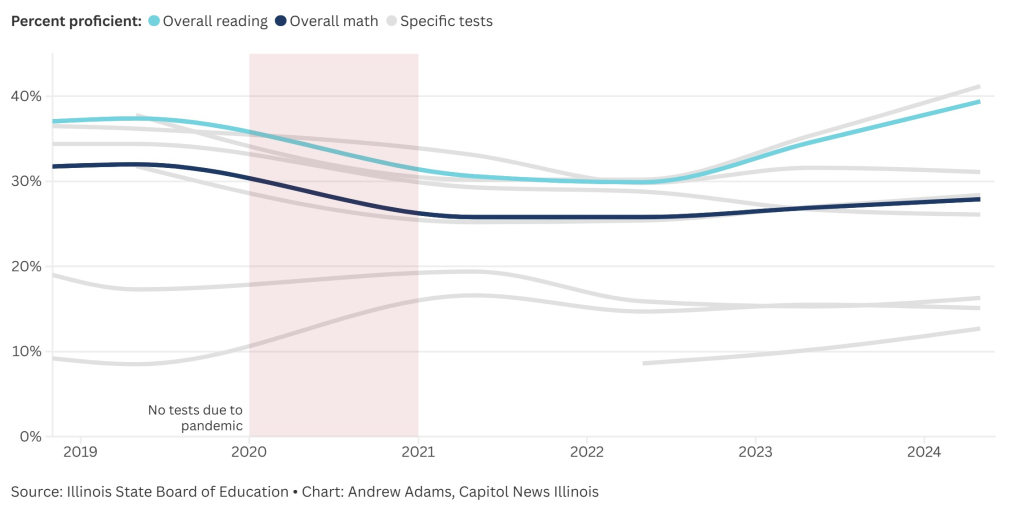
By PETER HANCOCK
Capitol News Illinois
[email protected]
SPRINGFIELD – Illinois education officials plan to launch a statewide initiative over the next several months aimed at boosting student performance in math.
State Superintendent of Education Tony Sanders made that announcement during a recent media briefing to unveil the most recent school report card. That annual report shows how individual schools, districts, and the state as a whole are performing across a wide range of educational measures, including academic performance in English language arts, and math.
“This will be the first-of-its-kind effort here in the state of Illinois,” he said. “As a state, we adopted new learning standards for math in 2010, but there’s never been a concerted statewide effort to provide support to educators in understanding and implementing these shifts in instruction.”
The new report, which is based on standardized tests students took in the spring of 2024, shows student scores in English language arts have fully recovered statewide from the hit they took during the pandemic.
More than 39% of all students scored at or above the state standards for proficiency in English language arts, including a record-high 41% for students in grades 3-8.
But in math, where proficiency rates have always been lower, overall scores remained troublingly low. Only about 28% of all students, and 28.3% of students in grades 3-8, met or exceeded state standards for proficiency.
Math scores also continued to show disturbing gaps across racial and ethnic lines. Across all grade levels, 38% of white students met the state’s proficiency standard, compared to just 15.3% of Hispanic students and 8.9% of Black students.
Sanders cautioned against drawing overly broad conclusions from those numbers, noting that Illinois sets a relatively high bar for what qualifies as “proficient.”
The report card divides test scores into five broad categories, based on the state’s definition of “proficient.” The two highest categories are “met” and “exceeded” the standard. Below those are “approached,” “partially met,” and “did not meet” the standard.
But the dividing line that marks the “proficiency standard” in Illinois – what testing officials refer to as the “cut score” – is higher than it is in most other states, Sanders said.
“We frequently mislabel students who are actually college and career ready as not being proficient,” he said. “We have already begun the work to realign our proficiency benchmarks, to give us more accurate data, to better support our outcomes. You’ll see that effort unfolding over this coming school year.”
Sanders pointed to other elements of the report card showing improvement in the rate at which schools are preparing students for college or a career after graduation.
For example, the four-year graduation rate rose to 87.7% for the class of 2024, an increase of 1.5 percentage points from the pre-pandemic class of 2019.
The 2024 report card also showed fewer students being required to take remedial math or English courses in community college after graduating from public schools in Illinois. That figure is 27.7% for the graduating class of 2022, down from 39.1% for the class of 2019.
“We have succeeded in reducing the number of students who have to take remedial coursework by implementing transitional math and English courses in high school statewide,” Sanders said. “Passing a transitional math or English course guarantees a student direct placement into credit-bearing courses at all community colleges and accepting Illinois universities without a placement test.”
Sanders offered few details about what would be included in the upcoming math and numeracy plan, except to say it would largely mirror the statewide literacy plan that the State Board of Education launched in February, a program he said was at least partially responsible for the increase in English language arts proficiency rates.
“The comprehensive literacy plan that we developed has been noted nationwide as being probably a model for how to approach literacy instruction,” Sanders said.
Capitol News Illinois is a nonprofit, nonpartisan news service that distributes state government coverage to hundreds of news outlets statewide. It is funded primarily by the Illinois Press Foundation and the Robert R. McCormick Foundation.






